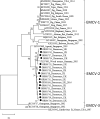Prevalence and Molecular Analysis of Encephalomyocarditis Virus-2 in the Hazel Dormouse
- PMID: 38653850
- PMCID: PMC11897066
- DOI: 10.1007/s10393-024-01680-z
Prevalence and Molecular Analysis of Encephalomyocarditis Virus-2 in the Hazel Dormouse
Erratum in
-
Correction: Prevalence and Molecular Analysis of Encephalomyocarditis Virus-2 in the Hazel Dormouse.Ecohealth. 2025 Jun;22(2):309-310. doi: 10.1007/s10393-025-01709-x. Ecohealth. 2025. PMID: 40067505 Free PMC article. No abstract available.
Abstract
The hazel dormouse (Muscardinus avellanarius) population in the UK continues to decline due to habitat loss, despite reintroductions of captive-bred individuals being conducted nationally for over 30 years. Disease surveillance of captive-bred and wild dormice is performed to identify novel and existing disease threats which could impact populations. In this study, we firstly investigated cause of death in seven hazel dormice found dead in England, through next-generation sequencing identifying a virus closely related to a wood mouse encephalomyocarditis virus-2 (EMCV-2). Subsequently, lung tissue samples from 35 out of 44 hazel dormice tested positive for EMCV-2 RNA using a reverse transcriptase quantitative polymerase chain reaction (RT-qPCR) and Sanger sequencing methods developed in this study. Formalin-fixed tissues available for nine hazel dormice which tested positive for EMCV-2 RNA were examined microscopically. Three cases showed moderate interstitial pneumonia with minimal to mild lymphoplasmacytic myocarditis, but no evidence of encephalitis. However, the presence of possible alternative causes of death in these cases means that the lesions cannot be definitively attributed to EMCV-2. Here, we report the first detection of EMCV-2 in hazel dormice and conclude that EMCV-2 is likely to be endemic in the hazel dormouse population in England and may be associated with clinical disease.
Keywords: Cardiovirus; Muscardinus avellanarius; EMCV-2; Encephalomyocarditis virus; Hazel dormouse.
© 2024. EcoHealth Alliance.
Conflict of interest statement
The authors declared no potential conflicts of interest with respect to the research, authorship and/or publication of this article.
Figures


Similar articles
-
Mastomys natalensis is a possible natural rodent reservoir for encephalomyocarditis virus.J Gen Virol. 2021 Mar;102(3). doi: 10.1099/jgv.0.001564. Epub 2021 Feb 3. J Gen Virol. 2021. PMID: 33533710
-
Encephalomyocarditis virus infection in a splenectomised calf.Aust Vet J. 2013 Sep;91(9):391-4. doi: 10.1111/avj.12096. Aust Vet J. 2013. PMID: 23980833
-
Rapid diagnosis of encephalomyocarditis virus infections in pigs using a reverse transcription-polymerase chain reaction.J Virol Methods. 1997 Jun;66(1):83-9. doi: 10.1016/s0166-0934(97)02214-3. J Virol Methods. 1997. PMID: 9220393
-
The encephalomyocarditis virus.Virulence. 2012 Jul 1;3(4):351-67. doi: 10.4161/viru.20573. Epub 2012 Jun 22. Virulence. 2012. PMID: 22722247 Free PMC article. Review.
-
Encephalomyocarditis Virus in Non-Domesticated Species.Pathogens. 2025 Apr 20;14(4):397. doi: 10.3390/pathogens14040397. Pathogens. 2025. PMID: 40333196 Free PMC article. Review.
References
-
- Amaddeo D, Cardeti G, Autorino GL (1995) Isolation of encephalomyocarditis virus from dormice (Myoxus glis) in Italy. J Wildl Dis 31. 10.7589/0090-3558-31.2.238 - PubMed
-
- Billinis C (2009) Encephalomyocarditis virus infection in wildlife species in Greece. J Wildl Dis 45. 10.7589/0090-3558-45.2.522 - PubMed
-
- Cerutis DR, Bruner RH, Thomas DC, Giron DJ (1989) Tropism and histopathology of the d, b, k, and mm variants of encephalomyocarditis virus. J Med Virol 29:63–69. 10.1002/jmv.1890290112 - PubMed
MeSH terms
Substances
Grants and funding
LinkOut - more resources
Full Text Sources

